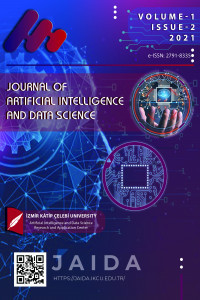Electron Beam Welding (EBW) of Aerospace Alloy (Inconel 825): Optimization and Modeling of Weld Bead Area
Electron Beam Welding (EBW) of Aerospace Alloy (Inconel 825): Optimization and Modeling of Weld Bead Area
___
- [1] B. Choudhury, and M. Chandrasekaran, “Electron beam welding of aerospace alloy (inconel 825): a comparative study of RSM and ANN modeling to predict weld bead area,” Optik - International Journal for Light and Electron Optics, Elsevier GmbH, vol. 219, 2020
- [2] J. W. Sowards, and J. Caron, “Weldability of nickel-base alloys,” Comprehensive Materials Processing, Elsevier, Oxford, vol. - 1, no. 6, pp. 151-179, 2014.
- [3] B. Choudhury, and M. Chandrasekaran, “Investigation on welding characteristics of aerospace materials –a review,” Selection and Peer-review under responsibility of the Committee Members of International Conference on Advancements in Aeromechanical Materials for Manufacturing, Elsevier, vol. 4, pp. 7519–7526, 2017.
- [4] M. Chandrasekaran, M. Muralidhar, C. M. Krishna, and U. S. Dixit, “Application of soft computing techniques in machining performance prediction and optimization: a literature review,” Int J Adv Manuf Technol, Springer-Verlag London Limited, vol. 46, pp. 445–464, 2009.
- [5] F. Khademi, S. M. Jamal, N. Deshpande, and S. Londhe, “Predicting strength of recycled aggregate concrete using artificial neural network, adaptive neuro fuzzy inference system and multiple linear regression,” International Journal of Sustainable Built Environment, Elsevier BV, vol. 5, no. 2, pp. 355-369, 2016.
- [6] R. Palanivel, I. Dinaharan, and R. F. Laubscher, “Application of an artificial neural network model to predict the ultimate tensile strength of friction welded titanium tubes,” J. Braz. Soc. Mech. Sci. Eng., Springer, vol. 41, no. 111, 2019.
- [7] M. F. A. Zaharuddin, D. Kim, and S. Rhee, “An ANFIS based approach for predicting the weld strength of resistance spot welding in artificial intelligence development,” J. Mech. Sci. Technol., Springer, vol. 31, no. 11, pp. 5467–5476, 2017.
- [8] K. Anand, R. Shrivastava, K. Tamilmannan, and P. Sathiya, “A comparative study of artificial neural network and response surface methodology for optimization of friction welding of incoloy 800 H.” Acta Metall. Sin. (Engl. Lett.), Springer, vol. 28, no. 7, pp. 892–902, 2015.
- [9] E. A. Gyasi, P. Kah, H. Wu, and M. A. Kesse, “Modeling of an artificial intelligence system to predict structural integrity in robotic GMAW of UHSS fillet welded joints,” Int. J. Adv. Manuf. Technol., Springer, vol. 93, pp. 1139–1155, 2017.
- [10] M. P. Satpathya, S. B. Mishraa, and S. K. Sahoob, “Ultrasonic spot welding of aluminum-copper dissimilar metals: a study on joint strength by experimentation and machine learning techniques,” J. Manuf. Process., Elsevier, vol. 33, pp. 96–110, 2018.
- [11] H. K. Narang, U. P. Singh, M. M. Mahapatra, and P. K. Jha, “Prediction of the weld pool geometry of TIG arc welding by using fuzzy logic controller,” Int. J. Eng. Sci. Technol., MultiCraft, vol. 3, no. 9, pp. 77–85, 2011.
- [12] N. Sivagurumanikandan, S. Saravanan, G. S. Kumar, S. Raju, and K. Raghukandan, “Prediction and optimization of process parameters to enhance the tensile strength of Nd: YAG laser welded super duplex stainless steel,” Optik, Elsevier Gmbh., vol. 157, pp. 833–840, 2018.
- [13] M. Akbari, S. Saedodin, A. Panjehpour, M. Hassani, M. Afrand, and M. J. Torkamany, “Numerical simulation and designing artificial neural network for estimating melt pool geometry and temperature distribution in laser welding of Ti6Al4V alloy,” Opt.– Int. J. Light Electron. Opt., 2016.
- [14] K. Anand, B. K. Barik, K. Tamilmannan, and P. Sathiya, "Artificial neural network modeling studies to predict the friction welding process parameters of incoloy 800H joints," Eng. Sci. Technol. Int. J., Elsevier BV, vol. 18, pp. 394–407, 2015.
- [15] K. R. Balasubramanian, G. Buvanashekaran, and K. Sankaranarayanasamy, “Modeling of laser beam welding of stainless steel sheet butt joint using neural networks,” CIRP J. Manuf. Sci. Technol., Elsevier, vol. 3, pp. 80–84, 2010.
- [16] I. Polatoglu, and L. Aydin, “A new design strategy with stochastic optimization on the preparation of magnetite cross-linked tyrosinase aggregates (MCLTA),” Process Biochemistry, vol. 99, pp. 131–138, 2020.
- [17] I. Polatoglu, L. Aydin, B. Ç. Nevruz, and S. Ozer, “A novel approach for the optimal design of a biosensor,” Anal. Lett., pp. 1–18, 2020. doi.org/10.1080/ 00032719.2019.1709075.
- [18] A. B. Ceylan, L. Aydin, and M. Nil, H. Mamur, İ. Polatoğlu and H. Sözen. “A new hybrid approach in selection of optimum establishment location of the biogas energy production plant,” Biomass Conv. Bioref, 2021. https://doi.org/10.1007/s13399-021- 01532-8
- Yayın Aralığı: Yılda 2 Sayı
- Başlangıç: 2021
- Yayıncı: İzmir Katip Çelebi Üniversitesi
Modeling and Design Optimization to Determine the Mechanical Properties of a Recent Composite
A Face Authentication System Using Landmark Detection
Identification of Breast Cancer Metastasis Using Boosting Algorithms on Cytopathologic Data
A Flower Status Tracker and Self Irrigation System (FloTIS)
Rumeysa KESKİN, Furkan GÜNEY, M. Erdal ÖZBEK
Fabric Defect Classification Using Combination of Deep Learning and Machine Learning
Fatma Günseli YAŞAR ÇIKLAÇANDIR, Semih UTKU, Hakan ÖZDEMİR
Turkish Character Usage in Text Classification
A Novel Approach for Detecting Defective Expressions in Turkish
